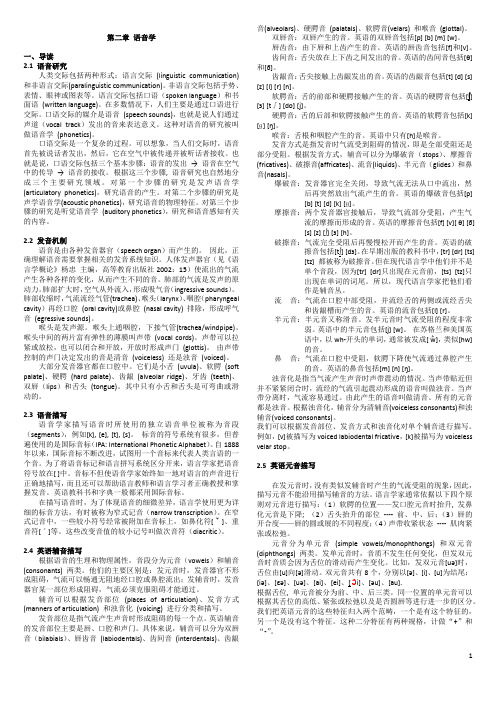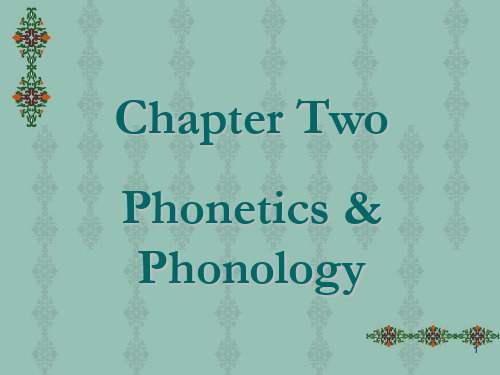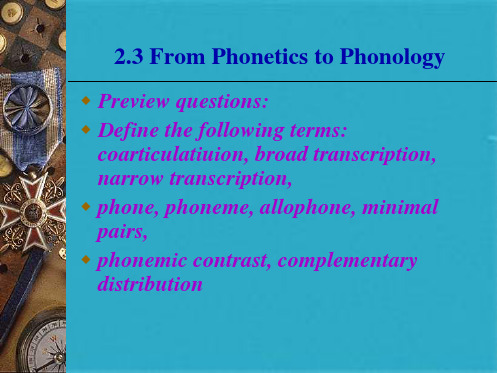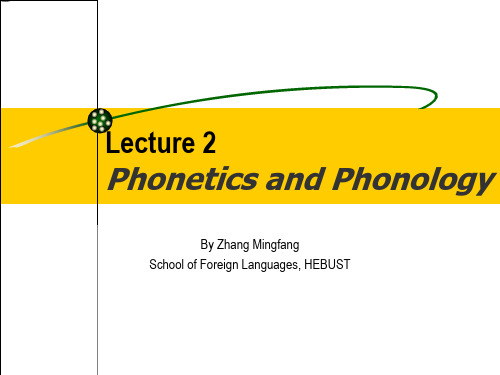英语语言学 第二章 Phonetics and Phonology
- 格式:ppt
- 大小:369.50 KB
- 文档页数:77


第二章语音学一、导读2.1 语音研究人类交际包括两种形式:语言交际(linguistic communication) 和非语言交际(paralinguistic communication)。
非语言交际包括手势、表情、眼神或图表等。
语言交际包括口语(spoken language)和书面语(written language)。
在多数情况下,人们主要是通过口语进行交际。
口语交际的媒介是语音(speech sounds),也就是说人们通过声道(vocal track)发出的音来表达意义。
这种对语音的研究被叫做语音学(phonetics)。
口语交际是一个复杂的过程。
可以想象,当人们交际时,语音首先被说话者发出,然后,它在空气中被传递并被听话者接收。
也就是说,口语交际包括三个基本步骤:语音的发出→语音在空气中的传导→语音的接收。
根据这三个步骤, 语音研究也自然地分成三个主要研究领域。
对第一个步骤的研究是发声语音学(articulatory phonetics),研究语音的产生。
对第二个步骤的研究是声学语音学(acoustic phonetics),研究语音的物理特征。
对第三个步骤的研究是听觉语音学(auditory phonetics),研究和语音感知有关的内容。
2.2 发音机制语音是由各种发音器官(speech organ)而产生的。
因此,正确理解语音需要掌握相关的发音系统知识。
人体发声器官(见《语言学概论》杨忠主编,高等教育出版社2002:15)使流出的气流产生各种各样的变化,从而产生不同的音。
肺部的气流是发声的原动力。
肺部扩大时,空气从外流入,形成吸气音(ingressive sounds)。
肺部收缩时,气流流经气管(trachea)、喉头(larynx)、咽腔(pharyngeal cavity)再经口腔(oral cavity)或鼻腔(nasal cavity) 排除,形成呼气音(egressive sounds)。

语言学第二章《Summary》特刊语言学第二章总结编辑:孙波任冲校对:汪燕华老师康亮亮一、Phonetics 语音学1、definition:Studies how speech sounds are produced, transmitted, and perceived.研究语音是如何产生,传递和感知。
2、Articulatory Phonetics、Acoustic Phonetics、Perceptual Phonetics发音语言学、声学语言学、感知语言学3、二、Phonology 音系学the study of the sound patterns and sound systems languages 研究语音模式和语音系统三、Voiceless & Voiced Sounds 清音和浊音1、Voiceless sounds:The sounds produced without causing vibration of the vocal cords. 在发音过程中,发音时声带不振动。
2、Voiced sounds:The sounds produced with causing vibration of the vocal cords. 在发音过程中,发音时声带振动。
四、Consonants & vowels 辅音和元音1、Consonants:sounds produced by constricting or obstructing the vocal tract at some places to divert, impede or completely shut off the flow of air in the oral cavity. 发音时,声道的某些部位受到压缩或阻碍后,使得气流在口腔里转向、受阻或完全被阻塞所发出的音。
2、Vowels:sounds produced without obstruction, so no turbulence or a total stopping of the air can be perceived. 发音时,声道不受到任何压缩或阻碍,因此不会有气流的紊乱或停滞所发出的音。


